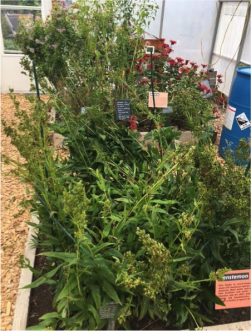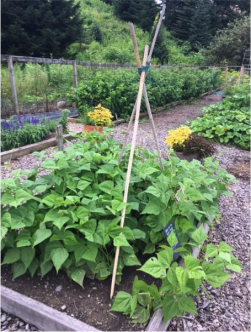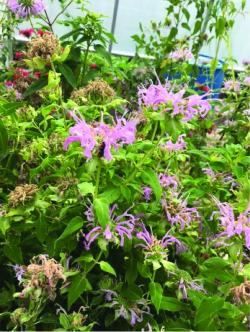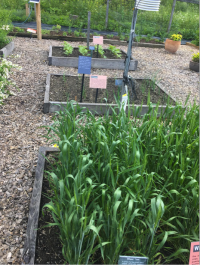Climate Change Garden Updates
Onions!
Thursday, August 10, 2017
By Amanda Sudilovsky ’19 (2017 Cornell Botanic Gardens Intern)
Additional note on our onions: The onions in the Climate Change Garden have performed differently than may be expected between inside and outside of the high tunnel. It may have been expected for them to be more successful outside since onions would prefer a cooler temperature. Instead, the onions inside the tunnel have grown much larger than outside. It is valuable to note that crops and varieties will respond differently according to the weather patterns of that season. Farmers and gardeners may use high tunnels to grow a better crop depending on these conditions. In this case, the high tunnel may have reduced the negative effects of wind and solar radiation. Can you infer that this variety will do better with higher temperatures as climate change progresses?
C-4 Plants to Replace Wheat
Thursday, August 10, 2017
By Amanda Sudilovsky ’19 (2017 Cornell Botanic Gardens Intern)
This week in the Climate Change Garden we removed wheat from the project beds and replaced them with weeds common in gardens and agricultural settings.
Why weeds?
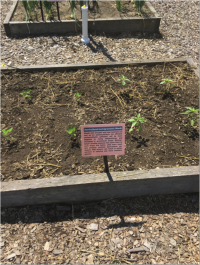 The weeds we planted— Lamb’s Quarters (Chenopodium album) and Pigweed (Amaranthus)—are C4 plants. This name designates a plant’s photosynthetic pathway. C4 plants include sorghum, millet, corn, sugarcane, and other grasses, which make up about 3% of all vascular plants. We planted C4 plants to show how well they adapt to heat and drought. All other plants in the Climate Change Garden are C3 plants. Under the climate conditions of 2050, it is expected that C4 plants will be more successful than C3 plants, which include beans, wheat, and trees.
The weeds we planted— Lamb’s Quarters (Chenopodium album) and Pigweed (Amaranthus)—are C4 plants. This name designates a plant’s photosynthetic pathway. C4 plants include sorghum, millet, corn, sugarcane, and other grasses, which make up about 3% of all vascular plants. We planted C4 plants to show how well they adapt to heat and drought. All other plants in the Climate Change Garden are C3 plants. Under the climate conditions of 2050, it is expected that C4 plants will be more successful than C3 plants, which include beans, wheat, and trees.
Why are C4 plants expected to be more successful than C3 plants?
When temperatures increase, plants close their stomata (pores) to reduce water loss. Closing stomata prevents gas exchange from occurring, which is necessary for plants to produce energy in the form of sugar, or photosynthesis. When this occurs, C3 plants are only able to fix oxygen stored in the plant instead of carbon dioxide, which prevents the plant from producing sugar. However, C4 plants are still able to perform photosynthesis when their stomata are closed because they store carbon dioxide in special cells in their leaves.
Why is this significant?
Because C4 plants are able to perform photosynthesis under warmer conditions than C3 plants, it is expected that C4 plants may grow larger and faster, yield more seed, and produce multiple generations per season. There is the potential for these weeds to crowd out C3 plants if they are more successful under the climate conditions of 2050, harming the balance of biodiversity.
Image above: Lamb’s Quarters (left) and Pigweed (right) are examples of C4 plants that we feature in the Climate Change Garden.
Project Beds Update, July 26 2017
By Amanda Sudilovsky ’19 (2017 Cornell Botanic Gardens Intern)
Since the last blog post, many of the project beds have continued to differentiate themselves between inside and outside of the high tunnel. In this time, the beds have each received a total of 7 inches of rain, or 91 gallons of water. In July of 2016, Tompkins County only received a maximum of 0.49 inches of rain during a single rain event. By comparison, in July of this year, Tompkins County dropped 2.41 inches of rain during a single rain event. It is predicted that as climate change continues, we will see an increased frequency of these large events with greater than 1-2” of precipitation falling during a single storm. This substantial increase in the amount of precipitation may cause noticeable differences in the plants from the previous drought year.
The indeterminate black beans have developed significantly to the point that we have set up poles along which they can climb. We expect more flowers to abort on those growing in the tunnel due to the high temperatures to which they are exposed. Follow them through the season and see if you can distinguish a difference.
The Monarda fistulosa and Penstemon digitalis both had to be tied up to prevent them from drooping into the walkway. Finally, predatory mites (biocontrols) have been added to the beans to prevent spidermite damage to the plants. So far, we have not noticed any twospotted spider mites on the beans that caused damage in previous years. Parasitic wasps have been introduced to the tunnel to control aphids on the Monarda didyma.
One of the important features of these past few weeks was the maintenance of a heat wave in the tunnel. We started this heat wave when the beans started to flower in order to test whether the exposure to high temperatures would cause the plants to drop flowers before producing fruit. This disruption could significantly decrease yields. At this point, the effects of the heat wave on the beans is unclear. (Shown left:The pole structure was created to provide support for the beans. Shown right: The Monarda and Penstemon were tied to keep the plants from being damaged on the ground.
The wheat in the tunnel fully matured during this time. It was harvested just a few days ago. The wheat outdoors will soon follow, but unfortunately, yields may be lower due to pests such as birds and chipmunks that have been feeding on the plants. Now we must begin to prepare for the next set of plants that will go in these project beds within the next month. Can you spot pollinators on the Monarda fistulosa shown below?
What is happening in the project beds?
Climate Change Garden Blog 7/5
By Amanda Sudilovsky ‘19
The Climate Change Garden is beginning to reach maturity from the purple blooms on the Salvia farinaceae “Victoria” to the grains on all three varieties of wheat. In addition to plant maturity, protocols have matured within the garden. We have introduced soil moisture reading in the project beds for the first time this season in order to prevent reaching drought levels since the plants rely solely on rainwater levels.
Now let’s check in on how the project beds are developing!
The Monarda is doing much better outside than inside the high tunnel.  Both Monarda dydima and fistulosa are taller outside than inside. Another noticeable difference is that the Monarda fistulosa has begun to bloom inside and not outside. This earlier bloom inside is likely due to the increased temperature.
Both Monarda dydima and fistulosa are taller outside than inside. Another noticeable difference is that the Monarda fistulosa has begun to bloom inside and not outside. This earlier bloom inside is likely due to the increased temperature. 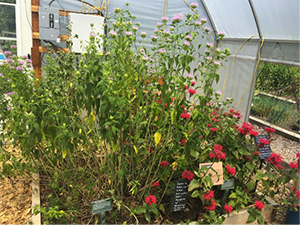 A final noticeable difference in the Monarda is in the Monarda dydima. Aphids continue to be present in the hoop house and not outside. This is a common problem in greenhouses and may not be caused by the Climate Change conditions inside the hoop house. To combat this pest, we will be adding a biocontrol, Aphidius colemani. This parasitic wasp will lay its eggs inside the aphids. Once these eggs hatch, the larvae will consume the aphid and emerge to seek out others. Shown left: The Monarda beds outside the tunnel. Shown right: Mondarda beds inside the tunnel.
A final noticeable difference in the Monarda is in the Monarda dydima. Aphids continue to be present in the hoop house and not outside. This is a common problem in greenhouses and may not be caused by the Climate Change conditions inside the hoop house. To combat this pest, we will be adding a biocontrol, Aphidius colemani. This parasitic wasp will lay its eggs inside the aphids. Once these eggs hatch, the larvae will consume the aphid and emerge to seek out others. Shown left: The Monarda beds outside the tunnel. Shown right: Mondarda beds inside the tunnel.
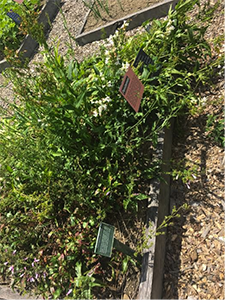 The Penstemon appears to be developing similarly inside and outside of the tunnel. Both are finished blooming for the season. An issue the team has noticed is that the Penstemon digitalis both inside and outside of the tunnel are experiencing a collapse. The team has not yet determined the causation of this problem nor a solution.
The Penstemon appears to be developing similarly inside and outside of the tunnel. Both are finished blooming for the season. An issue the team has noticed is that the Penstemon digitalis both inside and outside of the tunnel are experiencing a collapse. The team has not yet determined the causation of this problem nor a solution.
The Penstemon digitalis seems to have collapsed for unknown reasons. Do you have an idea of why this may be?
Shown left: Penstemon digitalis outside of the high tunnel.
The Hypericum prolificum and kalmianum ‘Blues Festival’ are blooming both inside and outside of the high tunnel. The plants do not display many noticeable differences between the inside and outside beds.
 Wheat is in its final stretch of growth. Grains inside and outside the tunnel seem to be reaching equal maturity. These grains are currently still green and have not yet hardened. It is expected that the wheat will be ready for harvest within a few weeks.
Wheat is in its final stretch of growth. Grains inside and outside the tunnel seem to be reaching equal maturity. These grains are currently still green and have not yet hardened. It is expected that the wheat will be ready for harvest within a few weeks.
Shown left: 'Red Fife’ wheat is a heritage variety that displays various heights.
The onions inside the high tunnel have continued to dramatically out develop those outside. The plants outside did not recover after exposure to wind or solar radiation. The garden team is allowing the onions to continue to grow as we are using this year and plant data to determine which plants should be used in the garden in the coming years.
(Below left: Onions outside the high tunnel. Below right: Onions inside the tunnel. )
)

The beans are developing well both inside and outside the high tunnel. In order to prevent an infestation of twospotted spider mites this year, the team has decided to introduce a biocontrol. Neoseiulus californicus consumes twospotted spider mites in order to develop. This will prevent the spider mites from consuming the bean plants later in their development.
Come see how the project beds are developing for yourself!
How are the perennials doing?
Friday, June 30, 2017
The perennial plants are also displaying differences between the outside and inside of the high tunnel. Both species of Monarda are much healthier out of the tunnel. Inside the tunnel, in addition to less vigor, we have noticed aphids on the Monarda dydima that are not present outside. Finally, Penstemon hirsutus flowered much earlier inside the tunnel and has since senesced.
I have had a fun time planting our display beds in addition to observing the project beds! We have continued last year’s theme for display beds to contain plants that are resistant to drought and may be appropriate for use in the future with the effects of climate change. These plantings also help to frame and separate the Climate Change Garden from the Pounder Vegetable Garden. At the entrance of the garden to the right, there are multiple shrubs (Caryopteris x clanodensis ‘Beyond Midnight’). The northern display borders consist of a strip of Hylotephium (Sedum) ‘Autumn Joy’, Salvia farinacea ‘Victoria’, Anemone virginiana, a native plant, Nassella tenuissima ‘Ponytails’, and Salvia nemorosa ‘Marcus’.
The southern border of the garden contains Hylotephium (Sedum) ‘Autumn Joy’, Pennisetum alopecuroides ‘Prairie Winds’, Caryop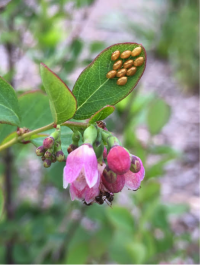 teris x clanodensis ‘Beyond Midnight’, Salvia farinacea ‘Victoria’, Lobelia erinus, and Salvia patens.
teris x clanodensis ‘Beyond Midnight’, Salvia farinacea ‘Victoria’, Lobelia erinus, and Salvia patens.
In an attempt to guide visitors to the beginning of the self-guided tour, we have situated two planters, narrowing the path at the Southwest corner of the garden. Included in these pots are Strobilanthes dyerianus ‘Persian Shield’, Salvia coahuilensis, Lobelia erinus, and varieties of Coleus. The garden is quickly becoming more interesting, colorful, and beautiful each day!
Come see how the garden has grown for yourself!
(shown left: Symphoricarpos orbiculatus at the entrance of the Climate Change Garden)
What's happening this year
Friday, June 30, 2017
Hi there! I’m Amanda, this year’s Cornell Botanic Gardens Education intern here in the Climate Change Garden. I am very excited to be involved in this garden’s fourth year as I see it as a valuable tool to demonstrate the effects of climate change to the public. I hope to learn how the project team will continue to use the garden as a medium for education.
In my first few weeks in the garden, I have spent much of my time learning about the protocols for water and temperature that are necessary to model the potential effects of climate change on plants in 2050. In this time, I have seen drastic changes in the plants between those outside and inside of the high tunnel.
This year’s project beds include both perennials and annual food crops. The perennials include Hypericum (prolificum and kalmianum ‘Blues Festival’), Penstemon (hirsutus and digitalis), and Monarda (dydima and fistulosa). The food crops include wheat (‘Tom,’ ‘Glenn,’ and ‘Red Fife’), onions (‘Aisla Craig’), and dry beans (black beans ‘A-55’).
 When I first started working, many of the food crops were not yet established. Now, we have wheat, onions, and beans all growing! We expected the onions to do better than those in the tunnel, but they are not doing well at all. Despite the cooler temperatures outside, the combined effects of greater wind exposure and solar radiation prevented the onions from establishing well. Inside, the onions are doing very well! Another plant type displaying major discrepancies between the inside and outside is wheat. Inside the tunnel, the wheat has already begun to head up. This early “Boot Stage” will most likely cause lower production yields and lower biomass of the plants.
When I first started working, many of the food crops were not yet established. Now, we have wheat, onions, and beans all growing! We expected the onions to do better than those in the tunnel, but they are not doing well at all. Despite the cooler temperatures outside, the combined effects of greater wind exposure and solar radiation prevented the onions from establishing well. Inside, the onions are doing very well! Another plant type displaying major discrepancies between the inside and outside is wheat. Inside the tunnel, the wheat has already begun to head up. This early “Boot Stage” will most likely cause lower production yields and lower biomass of the plants.
Shown left: Outside photos of the food crops from week 1 of my internship.)
Bottom left:Outside photos of the food crops from week 3 of my internship
Bottom right: Can you notice the differences in growth of the food plants inside the high tunnel at week 3?
Creating A Landscape
Thursday, July 29th, 2016
Surrounding the Climate Change Garden is a collection of display plantings. The Pounder Vegetable Garden utilizes the majority of the space in the garden, while the Climate Change Garden is tucked in the corner of the garden at approximately a quarter of the total size of the space. The display beds form a visually pleasing division between these spaces. Even though the tour through the Climate Change Garden is self-guided, the display beds and signs are designed to indicate a sense of direction for the visitor. This is important in facilitating the visitor surveys because they are meant to evaluate whether the garden has impacted the visitor’s understanding of climate change in any way.
As you enter the Climate Change Garden, a bed to your right consists of compact shrubs (Bluebeard; Caryopteris xclandonensis ‘Beyond Midnight’) that will reach about 2 1/2 feet at maturity and will set panicles of blue flowers from late summer into fall. This boarder will help deter the visitor from walking into the neighboring beds of corn in the Pounder Vegetable Garden. After exiting the high tunnel, the visitor reaches the end of the garden tour surrounded in two large garden beds of Stonecrop (Hylotelephium spectabile “Autumn Joy”), annual salvia (Salvia farinaceae “Victoria”), perennial salvia (Salvia nemorosa “Marcus”), and Mexican feathergrass (Nassella tenuissima).
In addition to creating a guide through the garden, as well as adding a beautiful border, many of the chosen plants are resistant to droughts, making them appropriate choices for possible climates in 2050 as well as the hot and dry weather of this 2016 summer. Next year we plan to continue this theme along the south border of the garden.
Written by Jessica Barbini (2016 Cornell Botanic Gardens Intern)
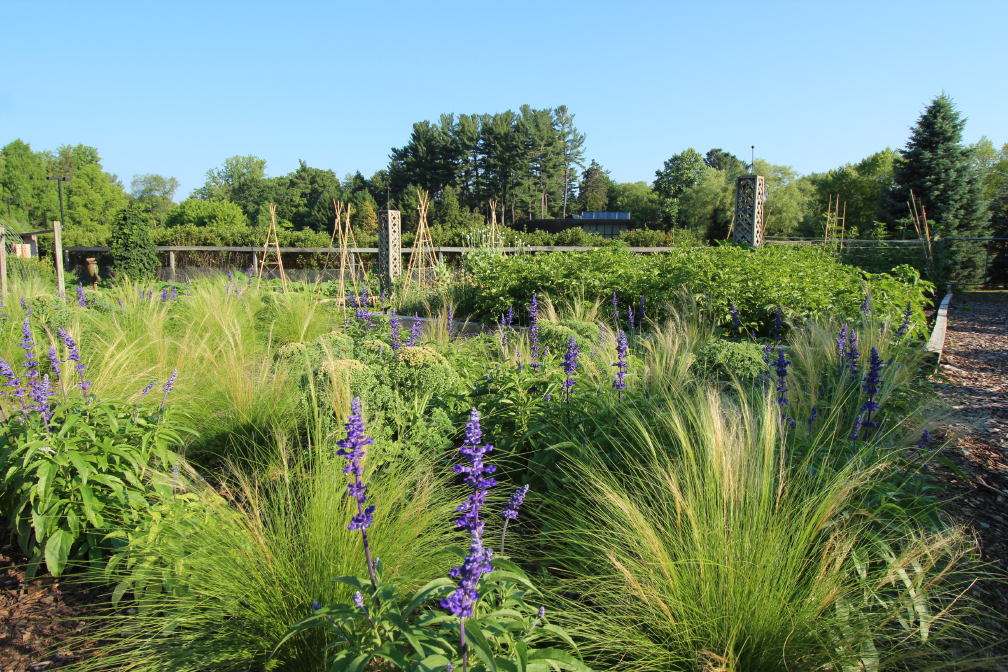
Effect of Climate Change on Different Bean Varieties
Friday, July 15th, 2016
According to Emeritus Cornell Botanic Gardens Director Chris Wien, bean plants exposed to high temperatures from approximately a week before and throughout flowering can cause the flowers to drop before producing fruit, greatly decreasing yields. From Thursday July 7th until Friday July 15th, we manually induced a heat wave in the high tunnel, in hopes of replicating early abscission, also known as flower drop. It is too soon to determine how the temperatures during the heat wave affected the plants; however, we can predict that the plants in the high tunnel, where the heat wave was imposed, will produce fewer beans than their counterparts grown outside.
One of the varieties growing, “Jubba”, is fairly sensitive to heat but produces flowers over a long period of time. “Jubba” is typically handpicked in multiple batches in East Africa and Western European for fresh markets. Multiple flowering flushes of “Jubba” make them less suited for mechanical or large-scale agriculture than the other variety we are examining. However, this same quality may also make them less vulnerable to heat waves expected as a result of climate change.


Images: Jubba outside, Jubba inside
The other bean variety, “Masai,” was bred for mechanical or large-scale agriculture. This variety produces all the flowers at once, maturing beans on each plant evenly. All the beans are approximately the same length for the purpose of canning. As extreme temperature events become more common as projected in 2050, a variety such as “Masai” may be more susceptible to flower drop.
Please stop by the garden to see if the heat affects the flowers!
Written by Jessica Barbini (2016 Cornell Botanic Gardens Intern)
Images: Beans outside, beans inside on the last day of the heat wave.
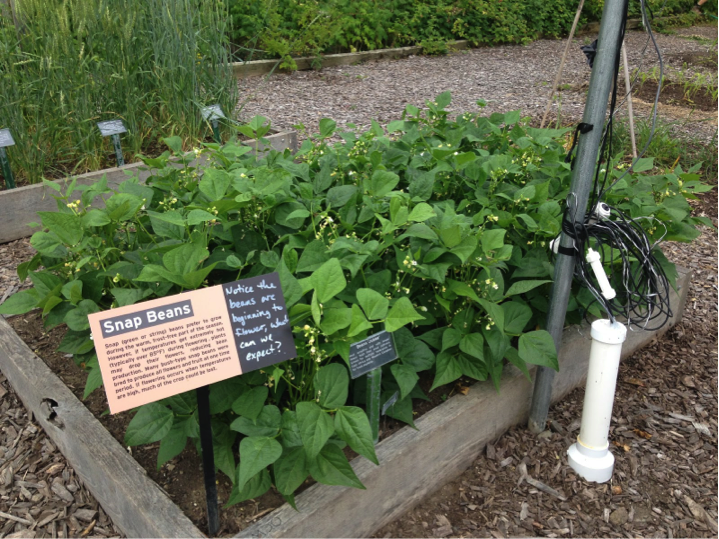
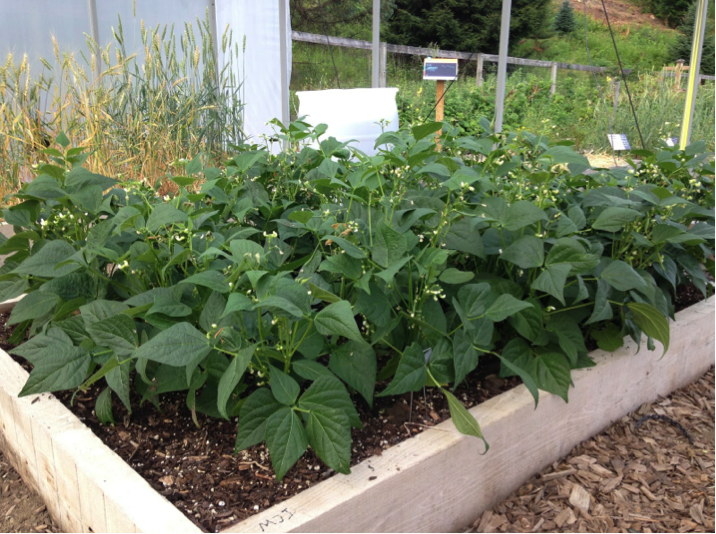
History of the Climate Change Garden
Wednesday, July 13th, 2016
In 2012, Cornell Assistant Professor Josh Cerra, Emeritus Cornell Botanic Gardens Director Chris Wien, and Director of Education Sonja Skelly began investigating the potential for a “Climate Change Education Garden” for increasing climate change awareness. Wien helped build the high tunnel, along with Cerra and a group of designers, which continues to play a key role in controlling environmental conditions. In addition to Josh Cerra and Chris Wien, Cornell Botanic Gardens Director of Education Sonja Skelly formed the original team members in the Climate Change Garden. With a background in anthropology and horticulture, Skelly provides a bridge across numerous disciplines involved and an appropriate focus for the project.
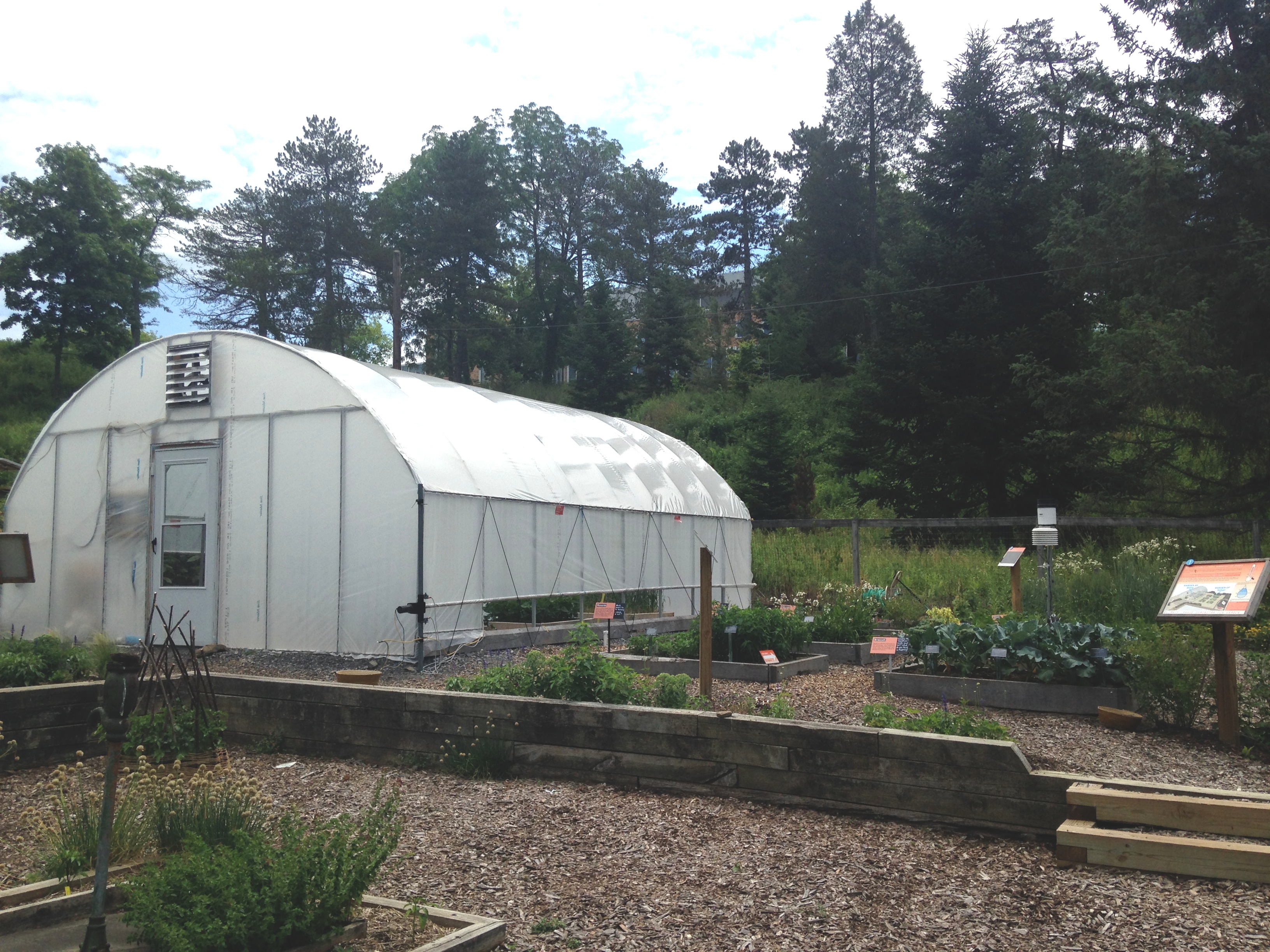
Images: Climate Change Garden 2016
The first year the team received funding through the Toward Sustainability Foundation and the consecutive two years through the Atkinson Center for a Sustainable Future. This funding allowed for the developing of the project in the Pounder Vegetable Garden at Cornell Botanic Gardens and continues to allow for others to work on the project as well. In the midst of the third year of the Climate Change Garden Education Experiment, the numerous hands involved in this project continue to grow. Pete Marchetto, Cornell PhD student with a background in physics and engineering, joined the project this past year. While serving as Teacher’s Assistant in Cornell Associate Professor Todd Walter’s ecohydrology graduate seminar, Marchetto assigned students the task of regulating the temperature inside the tunnel to be 5.5-6.3 degrees above the ambient temperature at all times to simulate middle range models for predicted temperatures in the year 2050.
In addition to Marchetto, Cristhian Corona joined the Climate Change Garden through the Nexo Global program, which partners students at the National University of Colombia with researchers at both Cornell University and Purdue University. Throughout his time here, Corona has developed both a theoretical and physical model to replicate rainfall in Ithaca, NY. Utilizing the velocity of raindrops, raindrop size distribution, duration of the rainfall, frequency of rainfall over time, and intensity, Corona has developed a highly realistic watering system mimicking Ithaca’s natural rain. You can access information about the progress in Corona's research here. He has a background in Civil Engineering from the National University of Colombia, but working with Cerra allows an exchange of insight between each of their disciplines. We hope to incorporate Cristhian’s watering system in future years.
As the Climate Change Garden continues to grow, people of various disciplines continue to join the project, such as Cornell Botanic Gardens employees: Donna Levy; Environmental Education Outreach Coordinator and Sarah Fiorello; Interpretation Coordinator. For this year’s garden, there has also been an addition of Graham Smith, and myself: Cornell Botanic Gardens Intern. Though the goals of the experiment have evolved over the years, they can now be articulated as choosing the right amount and types of plants, knowing how to treat those plants in a way that portrays climate change most obvious to the viewer, precise environmental controls implemented using the high tunnel, and a statistically relevant outcome through the visitor surveys and interpretation. This project is unique and the first of it’s kind but progressively becomes more finely tuned each year. As the project becomes lower maintenance, it is the hope that it will be replicated in other areas outside of Central New York to show climate change effects at other universities, botanic gardens, and museums around the globe.
Written by Jessica Barbini (2016 Cornell Botanic Gardens Intern)
Image: Josh Cerra and Graham Smith in the high tunnel. Visitors to the garden..jpg)
You Were Bread For This
Friday June 24th, 2016
As the summer continues, we are able to observe more differences between the plants inside and outside the high tunnel. We have three varieties of hard red spring wheat, Tom, Glenn, and Red Fife, some of which started to produce heads. Hard red spring wheat is planted in the spring and harvested in late summer or early fall. Different varieties of wheat are bred for different breads and dough (pun intended). Hard red spring wheat typically has a high protein content, making it good flour for baking breads and rolls. Different varieties can also be bred for other strengths, such as resistance to disease. The Tom variety is known for average yields and resistance to some fungal diseases, whereas the Glenn variety is known for high yields and early maturation. Red Fife is an Heirloom variety and was commonly used during the end of the 19th century into the 20th because of its’ adaptation to diverse growing conditions across Canada.
One might notice in the high tunnel, the three wheat varieties are all producing heads, and a few plants have started to flower. Though the plants inside are maturing at a faster rate, the wheat outside looks more lush and healthier overall. Plants that flower too early typically are stressed. For wheat, early flower maturation can even result in an overall reduction in yield.
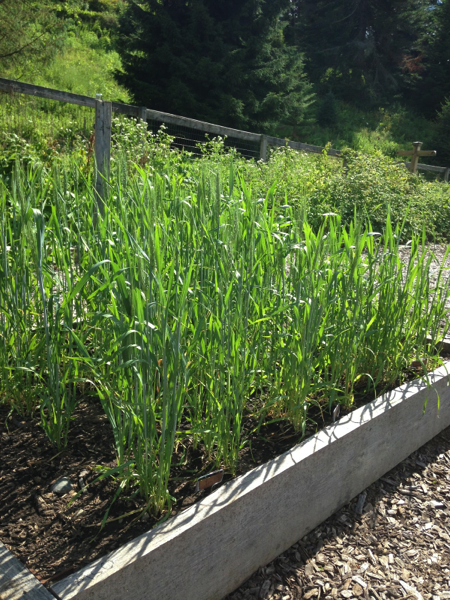
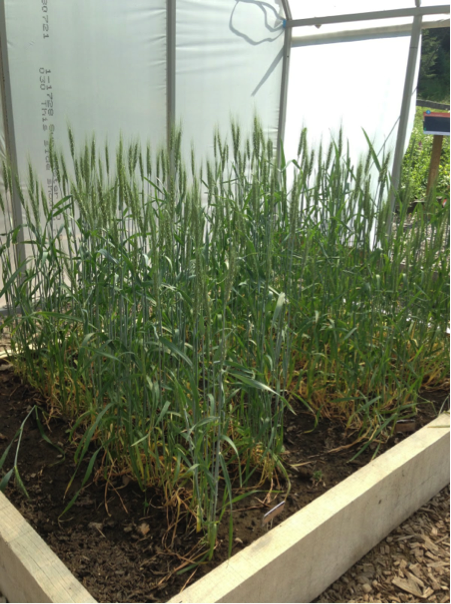
In addition to the differences in the wheat, it is clear that some of the perennials in the high tunnel are suffering, unlike those outside. The beardtongue (Penstemon) outside the tunnel has more flowers and leaves than those inside. Both the beardtongue (Penstemon) and bee balm (Monarda) outside the tunnel are generally more lush and healthy than those indoors.
To assure that a similar amount of water is delivered to plants inside and outside, we match rainfall in the tunnel the morning after rain. To prevent the plants from completely drying out, if there is no rainfall, we measure the soil moisture in the food crop beds and water a pre-determined amount if the sensor reads below a certain threshold. The perennial plants are given supplemental water only if they show two consecutive days of morning wilting. Watering the correct amount is made easy with the use of a calculation and a water meter attached directly to the hose. By watering in this way we can reduce the variables effecting plant growth and allow temperatures (predicted for 2050) to have a more of an impact on our observations.
Please stop by the Climate Change Garden any time!
Written by Jessica Barbini (2016 Cornell Botanic Gardens Intern)










